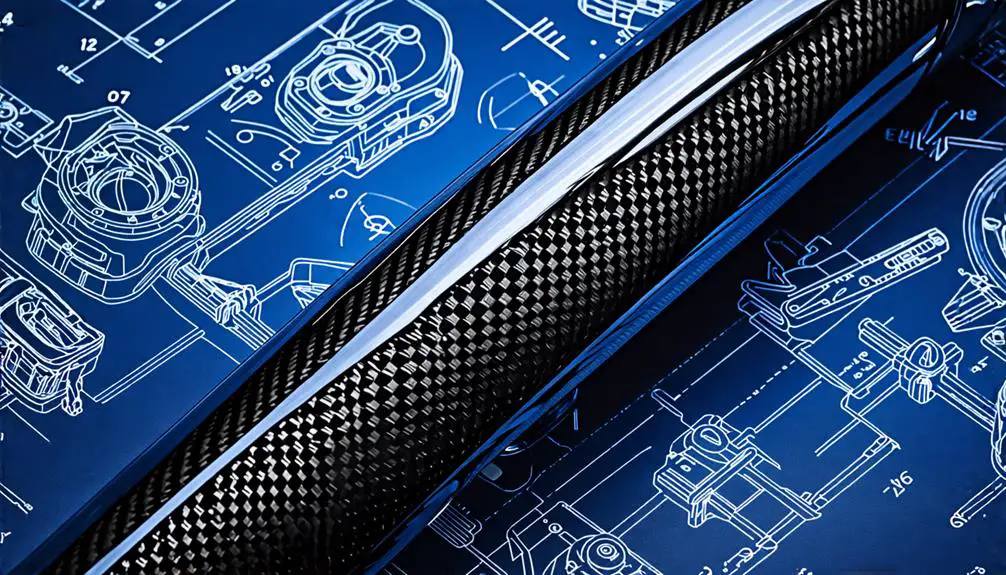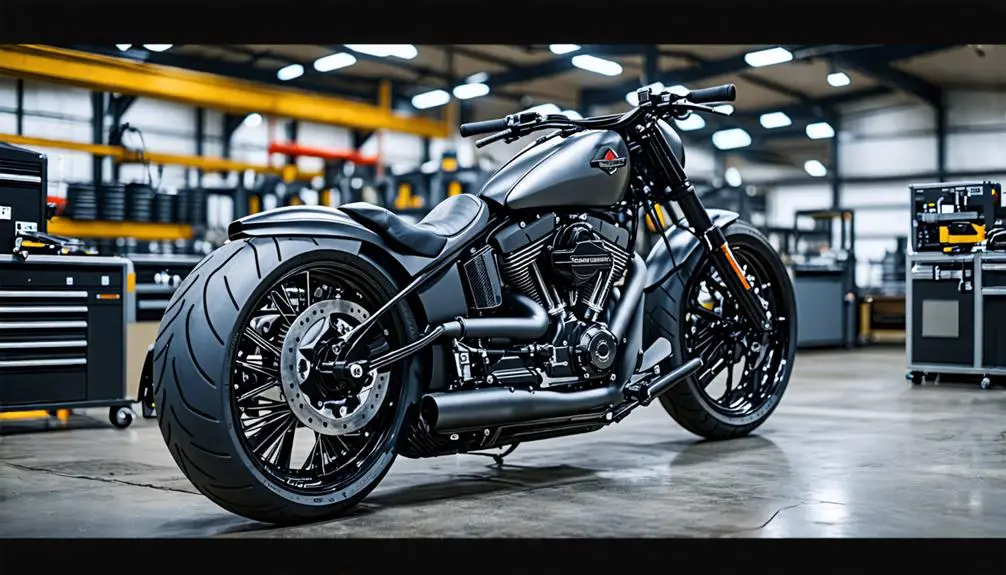Innovations in lightweight materials are revolutionizing Harley-Davidson technology, with advanced aluminum alloys, carbon fiber, and magnesium leading the charge. These materials reduce the overall weight of motorcycles, enhancing both performance and fuel efficiency. The strategic use of finite element analysis (FEA) guarantees that these lightweight components maintain structural integrity. Additionally, the incorporation of titanium adds strength without unnecessary bulk. How do these advancements affect rider comfort and handling, and what future materials might further transform Harley-Davidson motorcycles? The answers could redefine the riding experience for enthusiasts and professionals alike.
Quick Takeaways
- Aluminum alloys and magnesium covers in engines reduce weight without sacrificing structural integrity.
- Carbon fiber components enhance performance and agility with a high strength-to-weight ratio.
- Titanium fasteners and engine parts reduce weight by up to 20% and offer exceptional corrosion resistance.
- Magnesium frames and engine covers improve fuel efficiency and rider responsiveness.
- Finite element analysis (FEA) optimizes material usage while maintaining durability and safety.
Evolution of Lightweight Materials
The evolution of lightweight materials in Harley-Davidson technology has revolutionized motorcycle design and performance. By embracing advanced materials like aluminum and magnesium, Harley-Davidson has greatly enhanced the power-to-weight ratio of their motorcycles, especially evident in the Revolution Max 1250 engine.
This engine features single-piece aluminum cylinders and magnesium covers, which drastically reduce material mass without sacrificing structural integrity.
Finite element analysis (FEA) plays a pivotal role in this transformation. By meticulously analyzing each component, Harley-Davidson engineers guarantee that every ounce counts, eliminating unnecessary material and crafting a lighter, more agile frame.
This precision engineering not only elevates the bike's performance but also boosts handling, making it a dream for off-road and adventure riders seeking unbridled freedom.
The integration of lightweight materials goes beyond mere weight reduction. It enhances fuel economy, rider comfort, and overall efficiency.
By focusing on these innovations, Harley-Davidson stays true to its legacy of durability and safety while offering a modern, liberated riding experience.
The Revolution Max 1250 engine stands as a proof to how cutting-edge materials can redefine the boundaries of what's possible in motorcycle engineering.
Aluminum Alloys in Engines
Utilizing aluminum alloys in engine construction revolutionizes Harley-Davidson's approach to performance and efficiency. By integrating aluminum alloys into the Revolution Max 1250 engine, Harley-Davidson achieves significant weight savings without compromising structural integrity or performance. Engine components like lightweight aluminum cylinders and magnesium covers play a vital role in enhancing the motorcycle's power-to-weight ratio. This improvement translates to better handling and increased efficiency, allowing riders to experience a freer, more responsive ride.
Moreover, Harley-Davidson employs finite element analysis (FEA) to meticulously minimize material mass in engine components. This advanced engineering technique guarantees ideal weight savings while maintaining peak performance.
Aluminum's exceptional heat dissipation properties further contribute to the engine's cooling efficiency, essential for maintaining performance and longevity under high-stress conditions.
The integration of aluminum alloys in engine design not only elevates performance but also aligns with Harley-Davidson's commitment to innovative manufacturing and sustainability. This forward-thinking approach resonates with riders seeking liberation from conventional constraints, offering them a machine that's lighter, faster, and more efficient.
Harley-Davidson's strategic use of aluminum alloys underscores their dedication to pushing the boundaries of motorcycle engineering.
Carbon Fiber Components

Carbon fiber components are revolutionizing Harley-Davidson motorcycles, offering a remarkable blend of strength and lightweight properties. Harley-Davidson's integration of carbon fiber aims to reduce weight and boost performance without compromising durability. Known for its high strength-to-weight ratio, carbon fiber allows riders to experience improved handling and fuel efficiency, taking their journey to new heights of freedom.
The incorporation of carbon fiber in various parts, such as bodywork and structural components, leads to a significant reduction in overall motorcycle weight. This weight reduction translates directly to enhanced rider agility and comfort, allowing bikers to maneuver effortlessly and enjoy a more dynamic riding experience.
Advanced manufacturing techniques, particularly precision molding, enable Harley-Davidson to craft intricate carbon fiber shapes, guaranteeing these components fit seamlessly into their motorcycle designs.
Harley-Davidson's commitment to innovation shines through with the adoption of carbon fiber technology. Not only does it bring an aesthetic appeal with its sleek, modern look, but it also guarantees technical superiority.
Riders seeking liberation on the open road can now enjoy the perfect combination of style and performance, thanks to Harley-Davidson's forward-thinking approach to lightweight materials.
Titanium for Strength
Many recognize titanium's unparalleled strength-to-weight ratio as a game-changer in Harley-Davidson's pursuit of engineering excellence. This metal has revolutionized lightweight designs, enabling the iconic brand to offer motorcycles that aren't only robust but also agile.
Titanium's application in vital components like fasteners and engine parts has been instrumental in reducing overall motorcycle weight by up to 20%. This significant reduction delivers enhanced performance and superior handling, essential for riders seeking both speed and stability.
One of titanium's standout features is its exceptional corrosion resistance. This quality minimizes maintenance requirements and extends the lifespan of parts, which is particularly beneficial for motorcycles exposed to diverse environmental conditions.
Riders can enjoy longer intervals between services, freeing them to focus on the open road rather than the workshop.
The manufacturing process of titanium involves cutting-edge techniques such as titanium alloying and precision machining. These methods guarantee Harley-Davidson's components meet the highest standards of quality and reliability.
Magnesium in Motorcycle Design

Harley-Davidson leverages magnesium in its motorcycle design to achieve significant weight reduction, particularly in engine covers and frames.
This lightweight material not only lessens overall mass but also enhances structural integrity through finite element analysis, ensuring robust performance.
Weight Reduction Benefits
Leveraging the exceptional properties of magnesium, motorcycle design at Harley-Davidson has taken a transformative leap toward weight reduction. Magnesium's high strength-to-weight ratio notably cuts down the overall weight of the motorcycle, making it a game-changer in the domain of performance and handling characteristics.
Riders seeking liberation on the open road will find that less weight translates to more agility and responsiveness, enhancing the sheer thrill of the ride.
The weight reduction benefits don't stop there. By utilizing magnesium in engine covers and other critical components, Harley-Davidson not only improves the power-to-weight ratio but also achieves greater fuel efficiency.
This means riders can go further on a tank of gas, a clear win for those long, liberating journeys.
Furthermore, magnesium's lightweight properties open the door for innovative, aesthetically pleasing designs. These sleek, modern looks don't compromise durability or safety, offering riders a machine that's as tough as it's beautiful.
Harley-Davidson's commitment to advanced engineering and technology shines through in their use of magnesium, allowing for more efficient production methods and pushing the boundaries of what's possible in motorcycle design.
Structural Integrity Enhancements
Harnessing the strength and lightweight properties of magnesium, Harley-Davidson greatly enhances the structural integrity of their motorcycles. By incorporating magnesium components, the company not only reduces overall weight but also guarantees that the motorcycles remain robust and durable. This strategic use of lightweight materials is pivotal in maintaining a balance between agility and strength, liberating riders with a machine that's both responsive and reliable.
In particular, magnesium covers in the Revolution Max 1250 engine contribute considerably to a lower center of gravity. This improvement boosts stability during rides, allowing riders to navigate with greater confidence and control. The high strength-to-weight ratio of magnesium allows for the production of lightweight yet durable parts, optimizing the power-to-weight ratio essential for high-performance motorcycles.
Harley-Davidson employs advanced finite element analysis (FEA) in the design process, guaranteeing that every magnesium component meets stringent safety and performance standards. This meticulous approach assures that the motorcycles not only shed unnecessary weight but also retain their structural integrity.
Integrating magnesium into the chassis design enhances agility and responsiveness, particularly beneficial for adventure riding. Riders experience a newfound sense of freedom, knowing their bikes are both lightweight and structurally sound.
Performance and Efficiency Gains
Building on the structural integrity enhancements afforded by magnesium, the focus shifts to the substantial performance and efficiency gains realized in Harley-Davidson's motorcycle design.
By integrating magnesium components like engine covers and frames, Harley-Davidson has achieved a remarkable 20% weight reduction compared to traditional aluminum parts. This significant decrease in weight directly enhances the bike's power-to-weight ratio, boosting overall performance and enabling riders to experience newfound levels of freedom and agility.
Magnesium's high strength-to-weight ratio is a game-changer for those seeking efficient handling and superior maneuverability, especially in demanding off-road scenarios. The lighter mass means that the engine doesn't have to work as hard to propel the motorcycle, leading to optimized fuel efficiency—a vital factor for long-haul adventures and eco-conscious riders.
Moreover, Harley-Davidson employs advanced manufacturing techniques like finite element analysis (FEA) to minimize material usage without compromising structural integrity. This not only maximizes the benefits of magnesium but also guarantees robust performance under various riding conditions.
Advanced Composites
In the continual quest for innovation, Harley-Davidson has turned to advanced composites to revolutionize their motorcycle technology. By incorporating materials like carbon fiber and aluminum alloys, they've markedly reduced the weight of key components without sacrificing strength or durability.
Riders seeking liberation on the open road will appreciate how these lightweight materials enhance performance and handling.
The Revolution Max 1250 engine is a prime example of this transformation. Integrating advanced composites has improved the power-to-weight ratio, making for a more responsive and agile ride. The engine's design includes magnesium covers and single-piece aluminum cylinders, creating a lighter assembly that boosts fuel efficiency and agility.
This focus on weight reduction doesn't just mean faster speeds; it translates to better maneuverability and a more exhilarating riding experience.
Harley-Davidson's dedication to lightweight materials extends beyond engines. It's about enhancing overall rider comfort and maneuverability, particularly in newer models aimed at adventure touring and high-performance.
With advanced composites leading the charge, Harley-Davidson isn't just embracing the future—they're crafting it, ensuring every rider enjoys the ultimate sense of freedom and control on their journeys.
Finite Element Analysis

Harley-Davidson employs Finite Element Analysis (FEA) to optimize structural integrity and reduce the weight of motorcycle components.
By simulating stress distributions and identifying potential failure points, they guarantee durability while enhancing performance and efficiency.
This approach allows the creation of lighter materials that improve handling and fuel efficiency, underscoring the brand's dedication to innovation.
Structural Integrity Optimization
How does Harley-Davidson guarantee its motorcycles remain lightweight without compromising on strength? Through the strategic application of Finite Element Analysis (FEA), Harley-Davidson has mastered the art of structural integrity optimization.
By leveraging FEA, the company efficiently utilizes lightweight materials like aluminum and magnesium to craft components that are both strong and light. For instance, the Revolution Max 1250 engine boasts single-piece aluminum cylinders and magnesium covers, showcasing how material optimization can yield impressive results.
FEA allows Harley-Davidson's engineers to simulate stress and strain on various motorcycle components under real-world conditions. This assures every piece can withstand the rigors of the road while maintaining safety and durability.
The optimization of lightweight materials not only reduces the overall weight of their bikes, boosting handling and efficiency, but also enhances the aesthetic appeal through more streamlined designs.
Weight Reduction Techniques
Expanding upon structural integrity optimization, the focus now shifts to weight reduction techniques through Finite Element Analysis (FEA). Harley-Davidson employs FEA to revolutionize lightweight design, meticulously minimizing material usage while preserving the structural integrity of their motorcycles. This sophisticated method identifies stress points in motorcycle frames, allowing engineers to reinforce only necessary areas, thereby achieving considerable weight reduction.
A prime example is the creation of single-piece aluminum cylinders and magnesium covers. These engine components, developed through advanced FEA techniques, markedly decrease overall weight without compromising strength. The leaner engine components contribute to an improved power-to-weight ratio, enhancing the motorcycle's performance and handling characteristics.
Moreover, optimizing the lightweight design via FEA not only boosts efficiency but also improves fuel economy. By reducing weight, Harley-Davidson motorcycles offer a more agile and liberated riding experience, aligning with the desires of riders who crave freedom on the open road.
FEA's precise application in weight reduction showcases Harley-Davidson's commitment to innovation and excellence, ensuring their motorcycles remain at the forefront of performance and rider satisfaction. Through these cutting-edge techniques, Harley-Davidson continues to transform motorcycle technology, setting new standards in the industry.
Performance and Efficiency Gains
While leveraging Finite Element Analysis (FEA), engineers release substantial performance and efficiency gains in Harley-Davidson motorcycles.
FEA optimizes the design of motorcycle components, guaranteeing that they use the minimum amount of lightweight materials while maintaining structural integrity and performance. This advanced analysis technique has led to the creation of single-piece aluminum cylinders and magnesium covers, greatly reducing weight without sacrificing strength.
By simulating and analyzing stress distribution in motorcycle parts, FEA enhances durability and performance across various riding conditions.
The weight reduction achieved through the application of FEA and advanced materials contributes to improved handling and efficiency, thereby enhancing the overall riding experience. This technological advancement allows Harley-Davidson to produce motorcycles with a superior power-to-weight ratio, which translates to better acceleration and fuel efficiency.
Here are four key points to take into account:
- Optimized Design: FEA guarantees the most efficient use of lightweight materials.
- Single-Piece Components: Aluminum cylinders and magnesium covers reduce weight while maintaining strength.
- Stress Distribution Analysis: Enhanced durability and performance in diverse conditions.
- Improved Power-to-Weight Ratio: Better acceleration and fuel efficiency.
With FEA, Harley-Davidson isn't just engineering motorcycles; they're crafting a liberating riding experience.
Weight Reduction Techniques
Harley-Davidson employs a range of weight reduction techniques to produce motorcycles that are both high-performing and agile. By leveraging advanced lightweight materials, they've redefined what it means to ride free.
Engineers use finite element analysis (FEA) to minimize material mass in components, guaranteeing that each part contributes to a robust yet lightweight design. This meticulous approach results in motorcycles that are easier to handle and more responsive on the road.
Harley-Davidson has integrated single-piece aluminum cylinders and magnesium covers into their engine designs. These elements considerably reduce overall weight while enhancing the power-to-weight ratio, making every ride feel more dynamic.
The motorcycle chassis benefits from advanced lightweight materials, providing improved efficiency and handling characteristics. This focus on lightweight design principles means riders experience greater comfort without sacrificing the bike's structural integrity.
The liquid cooling system is another indication of Harley-Davidson's commitment to weight reduction. Designed with lightweight components, this system maintains ideal engine temperatures, contributing to the overall weight-saving strategy.
Impact on Performance

The meticulous application of weight reduction techniques directly influences the performance of Harley-Davidson motorcycles. By employing lightweight materials such as aluminum and magnesium, Harley-Davidson markedly reduces the overall weight of their bikes, leading to improved performance and handling dynamics. This innovative approach isn't just about shedding pounds; it's about transforming the riding experience.
Consider these key points:
- Revolution Max 1250 Engine: Integrating single-piece aluminum cylinders in the Revolution Max 1250 engine minimizes material mass. This results in a superior power-to-weight ratio and enhanced acceleration, providing riders with an exhilarating performance boost.
- Chassis Design: Updated models like the Street Glide® and Road Glide® utilize lightweight materials in their chassis design. This not only improves efficiency but also enhances rider comfort and aerodynamics, making long rides more enjoyable and freeing.
- Advanced Features: The use of lightweight materials allows for the inclusion of advanced systems such as liquid cooling. These systems maintain ideal engine temperatures while keeping weight to a minimum, ensuring consistent performance under various conditions.
- CVO Road Glide ST: Lightweight construction methods in this model contribute to its reputation for delivering the fastest performance in its class, directly showcasing the link between material innovation and top-tier performance capabilities.
The liberation of riding a Harley-Davidson is amplified through these cutting-edge advancements.
Future Material Innovations
Looking ahead, Harley-Davidson is set to push the boundaries of motorcycle design through groundbreaking material innovations. The company is increasingly leveraging lightweight materials like aluminum and magnesium to boost the power-to-weight ratio, enhancing overall performance and handling.
With finite element analysis (FEA), engineers can minimize material mass in components without compromising structural integrity, making bikes lighter and more agile. Advanced manufacturing techniques, such as CNC machining, allow for the precise fabrication of these lightweight components, ensuring they meet Harley-Davidson's high standards for performance and durability.
In addition, the strategic use of carbon fiber in select models offers unmatched strength-to-weight ratios, drastically improving agility and fuel efficiency.
But Harley-Davidson isn't stopping there. Ongoing research into solid-state batteries promises to revolutionize electric motorcycle design. These batteries aren't only lighter but also offer higher energy density and enhanced safety features.
As a result, future Harley-Davidson electric motorcycles could deliver unprecedented performance and longer ranges, liberating riders from the constraints of traditional fuel sources.
Common Questions
What Is the Lightest Harley-Davidson Made?
The 2023 Harley-Davidson Nightster stands as the lightest Harley-Davidson motorcycle ever made, with a curb weight of just 481 pounds (218 kg).
Featuring a lightweight aluminum frame and components, it's designed for enhanced performance and agility.
By integrating advanced materials like aluminum and magnesium, Harley-Davidson guarantees durability without the extra weight.
Precision manufacturing technologies like CNC machining contribute to the Nightster's liberation from traditional heavyweight constraints.
What Technology Does Harley-Davidson Use?
Harley-Davidson uses advanced technologies, including CNC machining, which guarantees precision and optimizes the riding experience.
Their motorcycles feature aluminum and magnesium components, improving power-to-weight ratios and overall performance.
Particularly, the Revolution Max 1250 engine employs advanced liquid cooling, reducing weight and managing temperature effectively.
Additionally, carbon fiber parts offer significant weight savings and enhanced durability, making riding a Harley a liberating experience for enthusiasts who crave freedom on the open road.
How Did Harley-Davidson Go Woke?
Harley-Davidson's shift towards inclusivity and sustainability reflects their "woke" transformation.
They've engaged diverse communities, committed to net zero environmental impact, and launched an electric motorcycle division.
By promoting a pre-owned program and focusing on employee welfare with equity grants, Harley-Davidson aligns with both social responsibility and environmental consciousness.
These initiatives resonate with a liberated audience, showing the company's dedication to progressive values and broader market appeal.
What Is the Future Outlook for Harley-Davidson?
Harley-Davidson is riding the wave to a promising future.
With "The Hardwire" plan, they're aiming for mid single-digit revenue growth and low double-digit EPS growth by 2025.
Investments in electric motorcycles and customer programs are revving up their market presence.
Plus, double-digit growth in Financial Services diversifies their revenue streams.
Harley-Davidson isn't just keeping pace; they're leading the charge toward innovation and sustainability.
Wrapping Up
Harley-Davidson's embrace of lightweight materials is like a master chef refining a classic recipe. By integrating advanced aluminum alloys, carbon fiber, and magnesium, they've trimmed the fat without losing the essence. Imagine a rider effortlessly carving through a mountain pass; that's the agility and performance these innovations bring. With finite element analysis ensuring every part is optimized, Harley-Davidson isn't just riding into the future—they're leading the pack with unyielding precision and style.